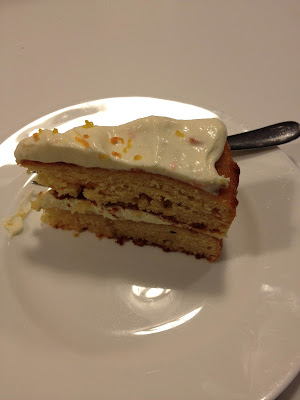 |
| Inside. Luscious. The perspective makes these look giant, they are in fact the same size as regular jaffa cakes. And that's a three year old holding one. |
I bake, not only because I love cakes 'n' stuff and I prefer home made, but I bake when I need to feel safe. I find baking immensely therapeutic. The fact that I'm quite skilled at it is helpful because when I'm, say, grappling with a difficult deadline, as if it were a salt water crocodile (and we know how slippy they can be) I have a need to achieve. I have an almost pathological need to achieve. Something. Anything.
And when that something happens to result in baking a good biscuit, just baked into a chewy crispness, with hidden little bullets of chocolate. Or a fluffy, jolly cake, heavy with a mascarpone frosting stained red with raspberries, so large that you have to dislocate your jaw to get a slice in...well where's the fucking harm in that.
When the news makes me feel like the world is too big, baking reminds me that the gentle stirring (or sometimes, vigorous whisking) of a few fine ingredients, can come together to make something good.
This is how I found myself making jaffa cakes.
Jaffa cakes. I don't even really like jaffa cakes. But they seemed tricky enough to take my mind off all the bad news.
This recipe is from Jamie magazine. They weren't tricky at all, but they did result in something so excellent and delicious and authentic (similar enough to shop bought ones to not alienate fans, different enough from to entice the not so keen) I had to keep eating them to make sure.
You need:
1 egg
50g caster sugar
65g self raising (I never sift flour but I guess you should)
butter for greasing
250g marmalade
100g 70% cocoa chocolate, chopped
Finely grated zest of half an orange
2 teaspoons of vegetable oil
(the original recipe also asks for a tablespoon of water to use when melting the chocolate) but I didn't use it and never use water in when melting chocolate).
You need a jam tart tin or shallow 'bun' tin with 12 holes. Grease this well, I also dusted it with flour (not from the 65g!)
Oven to 200C.
You do:
Okay so whisk the egg and sugar together, using an electric mixer if you have one (don't sweat if you haven't, you think sponge cakes were never made before the advent of the electric mixer?) if not by hand. Get those biceps and triceps working. Beat until the colour has lightened and the mixture has thickened. I'll admit this is a a hell of a lot easier with an electric mixer.
Now stir in the flour by hand.
This is so easy isn't it?
Now dollop about a tablespoon of the mixture into each hole, evenly. So if you get it wrong you'll need to go round and nick a bit from the moulds that have too much.
Bake in the oven for 8-10 mins. Be careful: you want them lightly golden.
When done turn out and let cool. When cool slice in half horizontally. Are you seeing these jaffas taking shape?
Hopefully you're the sort of person who reads recipes through before embarking on making something. And therefore you'll know that whilst the cakes are cooling, put the marmalade in a pan, on the stove. I didn't use the whole 250g but if you have any left over, once cool, you can put it back in the jar.
 |
| The sponge cakes fresh out of the oven. |
So, heat the marmalade until it's melted and stirrable and all one big thing and not little clumps of marmalade skulking round the pan, like nervous teenagers circling each other at a party, and then take off the heat and leave to cool. You can leave it for a good 20-30 mins, perhaps more and in fact it's easier to use when it's cooler. You could sieve out the peel in the marmalade but come on! Butch up and leave it in. I did and it was delicious.
 |
| Note the bit with a slice off? I ate it. Couldn't wait. |
Melt the chocolate, with the orange zest and oil (oil not essential but gives a nice gloss), in a bowl over a pan of water. When melted, spoon over each marmalade covered sponge. What I did was put the cooling rack over a baking tray to catch any drips (ahem, I took it away for the photo below for better contrast), and then pick up each sponge and spoon the chocolate over, spreading it delicatedly with the back of the spoon - you don't want to compromise the blobs of marmalade - then putting each back on the rack over the tray to catch any drips. And there were hardly any drips. I guess you could be more slap happy and just spoon the chocolate over each sponge whilst they're sat on the rack and let the chocolate drip gaily.
 |
| Just one left to do. |
But I think that's more wasteful.
I ate at least six of these waiting for the chocolate to set. My youngest went potty for them. My eldest doesn't like jaffa cakes and wasn't convinced by these.
Make them and tell me what you think.








